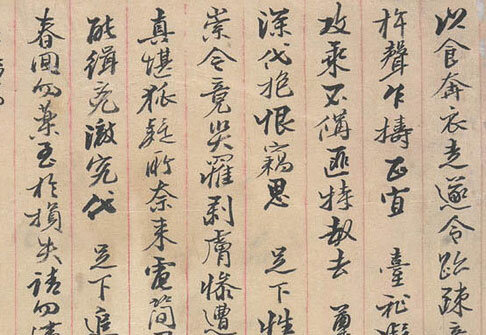
ELY FINCH
Historical Linguist and Consultant Translator
Literary Chinese and Cantonese
Introduction
Ely offers a niche Chinese-to-English-translation and consultancy service that is focussed on historical texts written in Literary Chinese (Classical Chinese), Cantonese, and related Southern Chinese vernaculars. His clientele includes academics, doctoral students, historians, museums, auction houses, and family-history researchers. See the About and Services pages for further detail.

The Poison of Polygamy
Ely’s largest translation to date, published by Sydney University Press in June 2019, is the long-lost novel The Poison of Polygamy, which is Australia's and possibly the West’s first Chinese-language novel.
Former president of the Australian Academy of the Humanities Emeritus Professor John Fitzgerald, speaking at the Melbourne launch of The Poison of Polygamy, Tuesday 22 October 2019:
“[This is] a moment to honour the precious and undervalued art of literary translation, exemplified in Ely’s richly annotated translation of a work of Literary Chinese, peppered with Cantonese terms of phrase. Casual readers of modern colloquial Chinese—among whom I count myself—who browse through the original text will recognise this as a truly daunting achievement that shouldn’t be underestimated, and it marks then the emergence of a very fine literary translator in Australia, and that is something to celebrate.”
Writing in the Spring 2021 volume of Delos: A Journal of Translation and World Literature, University of Florida Emerita Associate Professor Cynthia L. Chennault:
“The formatting of English and Chinese texts on facing pages is ideal for students of Literary Chinese to check their sense of the original against the superb translation by Ely Finch, a linguist and freelance translator. Teachers of Literary Chinese, take note! The story’s incidents of seduction and criminal activity—not to mention the internal calculations of some severely flawed characters—will provide gripping material for translation exercises.”
“[Finch] describes his method of translation as follows: ‘The approach taken to the translation has been both rigorous and ambitious. The sense and allusions of the original have, so far as practicable, been translated without resort to overt domestication— such as the replacement of unfamiliar Chinese literary allusions and ideas with Western ones. Explanatory footnotes have been used as a means of assisting readers to bridge a cultural and literary gulf.’ [Translator’s Introduction, 38–39] Although initially taken aback by the self-appraisal of the first sentence quoted above, after I read Finch’s translation accompanied by no fewer than 469 notes, I can only commend his meeting the high standard that he set for himself. Persons with the multiple abilities needed to produce an annotated translation of this novel must be rare. That is to say, in addition to familiarity with different kinds of Mandarin and the See Yip language, the translator must also be a well-informed scholar of China’s cultural heritage in order to explain traditional values, customs, idioms, euphemisms, and the like.”
Services
Annotated Historical Translation
The sensitive translation of historical texts, including old letters, account books, newspaper articles, and gravestone or temple-plaque inscriptions. Added explanatory annotations serve to highlight information of relevance that may be less than apparent from the base translation, such as the actual location of a named place; the name by which a person was known in English; an equivalent date on the Gregorian calendar; or an important implication of the original wording.
Literary Translation
The translation of literature and poetry in a manner that strives to preserve the sense, style and literary quality of the original.
Transcription
The transcription into a readable or searchable electronic form of an original text that may be written cursively, be partially mutilated, or employ pre-modern abbreviations or character forms.
Newspaper-archive Research
Searching for information of relevance to a client (for example, articles that relate to a specific person or firm) within Chinese-language-newspaper archives, such as the National Library of Australia’s Trove archive, and electronic archives of Singaporean, Canadian, Hong Kong, and late-Qing and early-Republican newspapers. This work often depends on knowing what search terms to use, which is in turn informed by familiarity with the language of the day, and knowing how characters corrupt when scanned by optical-character-recognition software.
Summarisation of Key Content
This is a less labour-intensive alternative to a carefully-fashioned translation, and is particularly well-suited to sets of texts, such as family letters or interrelated newspaper articles.
Family-history Research
Ely’s knowledge of historical language and obscure resources has proved invaluable in supporting the work of professional genealogists and private family-history researchers.
Banner image: collage by Sauce Design that comprises an image of the translator’s loupe; a document at right from the Chinese Chamber of Commerce of New South Wales collection at the Australian National University’s Noel Butlin Archives Centre (p.16 of “Miscellaneous correspondence mainly relating to the import of tea and the celebration of Confucius’ birthday”); a photograph of the China-Australia Mail Steamship Line vessel the s.s. Victoria (from p.1 of the supplement to the Christmas Day 1920 edition of Sydney’s Chinese Republic News: see http://nla.gov.au/nla.news-page24085762 on the National Library of Australia’s Trove website); the masthead of Melbourne’s Chinese Times (also available on Trove); at top left a section of a finely written Literary Chinese essay on the subject of Confucian philosophy (張爾岐撰中庸論) from an 1826 compilation (皇朝經世文編); and in red text the title page to late-Qing-era Cantonese intellectual Kang Yu Wei’s travelogue 歐洲十一國游記 “A Journey through Eleven European Countries”.





